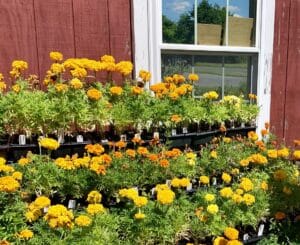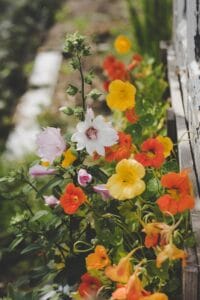Hello, fellow lovers of all things green: Many of you reached back with kind wishes and shared stories about your furry companions. Your kindness means so much. Jolee recovered quickly from her foot full of porcupine quills. As it turns out, Maria, the selfless hiker who stepped in to help, found me on the Garden Dilemmas Facebook Page, and we’ve become “pen pals.” It’s magical how life brings people and pets into our lives—much like perfect plant companions for our vegetable gardens.
Companion planting can be complicated and contradictory.

Three Sisters Gardening is featured on the reverse of the 2009 Native American U.S. dollar coin.
Attribution:
United States Mint, Public domain, via Wikimedia Commons
Last week, we spoke about Three Sisters Gardening, which stems from Native Americans who found that corn, pole beans, and squash, when grown in groupings, help support and nourish each other while maximizing space and crop yields. Other benefits of planting different crops together are controlling pests and encouraging beneficial insects and pollinators. However, the topic of companion planting is broad-reaching and can be complicated and contradictory.
For example, Wikipedia has a chart saying that carrots help tomatoes grow better, but tomatoes may stunt the carrots’ growth. Beans can give carrots nitrogen, which they need more than most veggies. So, are they saying the beans will counteract the stunting effects of tomatoes?
Some say rosemary, sage, and radishes repel carrot flies; others say they don’t make good companions. It’s true; the more you research, the more confusing companion planting can be. However, the central theme is that planting vegetables in groupings rather than rows of one crop is best. To follow are a few sure and straightforward combos that will also add color to your vegetable patch.
A few companions for veggies sure to add color:
Some companion plants serve as a “trap crop” to lure insects away from others, such as planting radishes around tomatoes to attract flea beetles, which prefer them over tomato plants. Flea beetles damage young seedlings, especially eggplant, and tomatoes, stunting their growth and lessening their yields.
Then there’s nasturtium, which draws pests like aphids, keeping them from attacking your veggies. They also deter squash bugs, so planting them amongst your zucchini or other summer squash is wise. Plus, they attract pollinators, including butterflies, bees, and hummingbirds.
Nasturtium flowers, seed pods, and leaves are edible, too—delightful in salads with their peppery mustard-like taste. They’re easy to grow with bold yellow and orange blooms and saucer-shaped foliage, adding color and texture to your vegetable garden. There are trailing varieties (Tropaeolum majus) and bush types, often called dwarf (T. minus).
 Marigolds make lovely veggie companions.
Marigolds make lovely veggie companions.
Most folks know about marigolds, which are deer-resistant and attract butterflies and hummingbirds. They’re often companion plants in veggie gardens to control insects and nematodes. They are also used as a spice in cooking.
Another floral beauty is sweet alyssum (Lobularia maritime), which helps control aphids when planted around lettuce. Both are cool-season plants, and you’ll adore the sweet fragrance of the dainty white clusters. They also make a great companion to Swiss chard. Like nasturtiums, they’re an annual here, but they readily self-seed and are edible. While they come in pink and purple, the white flowering sweet alyssum attracts the most pollinators and beneficial bugs like parasitic wasps that gather aphids to feed their young.
Combos such as tomatoes planted with basil not only taste great together, but they also help deter thrips, which can wreak havoc on peppers.
 Another note from last week—I asked your thoughts on whether it’s time to change the column photo. Monika kindly wrote, “You’ll know when it’s time.” Perhaps I’ll grab a picture of Jolee and me once the garden comes to life. It’s a season of new beginnings while cherishing the joys of the past—Happy Easter and Passover to all. Garden Dilemmas? AskMaryStone@gmail.com (and now on your favorite Podcast App.)
Another note from last week—I asked your thoughts on whether it’s time to change the column photo. Monika kindly wrote, “You’ll know when it’s time.” Perhaps I’ll grab a picture of Jolee and me once the garden comes to life. It’s a season of new beginnings while cherishing the joys of the past—Happy Easter and Passover to all. Garden Dilemmas? AskMaryStone@gmail.com (and now on your favorite Podcast App.)
There’s an update and more to the story in the Garden Dilemma’s Podcast (@10 soothing minutes):
Link to last week’s story if you missed it: Three Sister’s Gardening & Jolee’s Emergency
The Old Farmer’s Almanac has a helpful Companion Planting Guide for Vegetables.
*Header Nasturtium photo by Nareeta Martin on Unsplash
Post Updated 4/28/24



